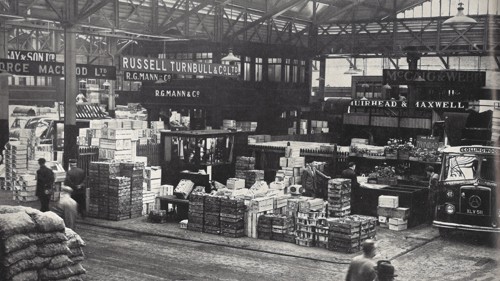Markets - Times Past

In partnership with the Glasgow Times, our archivists are exploring Glasgow's fascinating history. This week, Michael Gallagher writes about Glasgow's markets.
Glasgow has long been regarded as a major shopping destination. But the city owes its historical development less to the designer brands of the “style mile” than the humble marketplace.
Markets were essential in its early days as Glasgow grew from a small burgh into an important trading centre. In the late-12th century, King William the Lion granted the burgh the power to hold a market every Thursday. This was important as it allowed the city to generate customs and funds from the trade that flowed in, which enabled it to finance its activities. These early markets took place around the Mercat Cross until the mid-17th century.
During this period, various charters changed the date and frequency of the markets and different types were established to fulfil different needs. These moved location surprisingly often, which must have made shopping all the more challenging for Glasgow’s citizens since all foodstuffs were sold at markets, rather than shops.
Until 1845, Glasgow’s markets were run as one undertaking as part of the common good of the city. The subsequent passing of various acts again changed things and the Corporation became more and more involved by the turn of the 20th century.
A wide range of markets belonged to the Corporation by 1914. These included a Cheese Market on South Albion Street, a Fish Market on Bridgegate and even a Bird and Dog Market opposite Glasgow Green, which dealt in pet animals. The City Clothes Market on Greendyke Street traded old garments in an example of what one official publication called, rather haughtily, “the purely humanitarian care exercised by the Corporation for the benefit of the poorest classes.”
The largest market was the Bazaar, on the site of the current City Halls and Old Fruitmarket at Candleriggs. This initially sold an array of groceries, foodstuffs and even books and toys, but later specialised in fruit and vegetables, becoming the main such market in the west of Scotland. Its byelaws aimed to create a more genteel trading environment than some other markets, stipulating that “no drunk person shall enter the Bazaar”, and “no person shall swear or use profane or obscene language within the Bazaar”, with a potential fine of 40 shillings for any transgressors.
The fate of the Bazaar is symbolic of much of the retail trade. By the 1960s, changing demographics, shopping practices and transportation issues meant that a city centre market designed to meet the needs of a growing burgh could not keep up with the demands of the 20th century. The UK government encouraged the redevelopment of markets and, having visited examples across Europe and North America, Glasgow Corporation officials decided to relocate the market to a vast greenfield site in Blochairn. This foreshadowed the trend towards out-of-town retail that has characterised recent decades.
As the 20th century bore on, Glasgow’s unique, Corporation-owned markets were phased out. However, their enormous influence on the city’s development is still felt today.
